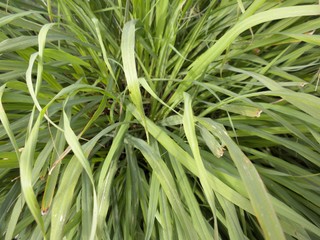How to grow lemongrass indoors

Lemongrass, a tropical herb native to Asia, Africa, and Australia, is celebrated worldwide for its citrusy flavor, especially in culinary delights. Besides its use in various cuisines, this herb boasts a multitude of applications, from teas to traditional medicine.
The good news? Growing lemongrass indoors is not as complicated as you might think.
With its ability to regenerate after harvesting, lemongrass can be a delightful, evergreen addition to your indoor garden.
To grow lemongrass indoors, choose a deep container. Start with seeds or, preferably, cuttings. Ensure the plant receives 6-8 hours of sunlight daily, or use a grow light if natural sunlight is insufficient. Maintain temperatures above 50℉ and ideally above 70℉. Water to keep the soil damp, avoiding excess moisture.
Indoor growing conditions
Lemongrass is native to tropical regions of Asia, Africa, and Australia; due to this, plants prefer sunny, hot growing conditions, making lemongrass well suited for growing indoors.
Best light conditions
Lemongrass loves sunlight. In its native habitat, it often basks in the full sun, so replicating this environment indoors is crucial.
- South-facing window: If you’re growing lemongrass in your home, positioning it by a south-facing window is ideal. This location typically receives the most sunlight throughout the day.
- Duration: Ensure that your lemongrass receives a minimum of 6-8 hours of sunlight daily.
- Grow lights: For areas where natural sunlight is limited, especially during winter months, consider using indoor grow lights. These lights can supplement or even replace natural sunlight, ensuring your lemongrass gets the illumination it needs.
Temperature requirements
Remember, lemongrass is a tropical plant. It’s used to warm conditions and can be sensitive to cold.
- Ideal temperature: Aim to maintain an indoor temperature above 70℉ for your lemongrass. This warmth mimics the tropical climates the plant is accustomed to.
- Avoiding the cold: Lemongrass can’t handle temperatures below 50℉. Ensure your plant isn’t near drafty windows or doors, especially during cooler months.
With the right light and temperature conditions, your indoor lemongrass will not only survive but flourish, providing you with fresh stalks ready for a variety of uses.
Other conditions
-
Soil type and pH Level: Lemongrass prefers well-draining soil. Heavy soils can cause root rot, so it’s essential to ensure the soil drains excess water effectively. While lemongrass isn’t overly fussy about soil pH, it generally prefers a slightly acidic to neutral pH range (6.0 to 7.5).
-
Humidity: Being a tropical plant, lemongrass prefers a humid environment. While it can tolerate drier indoor air, you might notice improved growth if you can increase humidity around the plant. This can be achieved by misting the plant occasionally, placing the pot on a tray of wet pebbles, or using a humidifier in the room.
-
Air circulation: Good air circulation helps prevent fungal diseases. Make sure the indoor area isn’t stuffy and allows for some movement of air. This can be achieved by occasionally running an oscillating fan or ensuring that the room has regular airflow.
-
Water quality: Lemongrass prefers chlorine-free water. If your tap water is treated with chlorine, consider leaving it out for 24 hours before watering or use filtered water.
-
Spacing: If you’re growing multiple lemongrass plants in one container or in separate pots nearby, ensure they have adequate space to grow. Crowding can reduce airflow and light access, which can affect their health.
While these factors are less important than temperature and light exposure, by addressing them properly you can significantly improve the health of your lemongrass.
Necessary supplies for indoor lemongrass cultivation
Picking the perfect pot
When you’re shopping for pots for your lemongrass, size matters. A 12-inch pot gives your lemongrass plenty of room to grow and spread its wings. Think of it as giving your plant its own spacious apartment. Fancy, right? We recommend this ceramic 12-inch pot from Fox & Fern.
If space is tight or you’re just trying things out, a 6-inch pot will do the trick. It’s like a cozy studio apartment for your plant. Just know it might get a bit cramped as the plant grows. Snag a four-pack of terracotta 6-inch pots here.
Coconut coir or potting soil
When you’re gearing up to plant lemongrass indoors, one of the big decisions is what type of soil to use. Let’s break it down:
Coconut coir is essentially the hairy outer husk of coconuts. It’s become quite the superstar in the gardening world lately.
| Pros of coconut coir | Cons of coconut coir |
|---|---|
| Airy structure: Excellent for root growth. | Nutrient lack: Needs frequent fertilizing. |
| Moisture retention: Holds water without waterlogging. | Price: Can be pricier than potting soil. |
| Eco-friendly: A sustainable option. |
Regular potting soil has been the go-to for indoor gardeners for years.
| Pros of potting soil | Cons of potting soil |
|---|---|
| Nutrient-rich: Good initial feed for plants. | Moisture retention: Can sometimes be excessive. |
| Versatility: Suitable for most indoor plants. | Consistency: Quality varies between brands. |
So, what’s the verdict for beginners?
If you’re just dipping your toes into the world of indoor gardening, we’d suggest starting with coconut coir. It’s forgiving with water, and lemongrass loves its airy structure. Just remember to give your plant some extra nutrients now and then since coir isn’t naturally rich in them. Coco Bliss is a good brand.
Sources for lemongrass: cuttings vs. seeds
Starting with cuttings is the most popular method. It’s quicker and often yields better results. Look for green, healthy stalks and plant them an inch deep into the substrate.
Alternatively, seeds can be used but they might take longer to germinate. If you opt for seeds, make sure they are fresh and from a reputable supplier.
Steps to plant lemongrass
Starting your indoor lemongrass garden is a rewarding experience. By following a few clear steps, you’re on the path to aromatic success!
Prepare and fill container
The first step is all about getting your pot ready.
Grab your clean, sterilized container. Fill it up with your chosen growing media (either coconut coir or potting soil) until there’s about an inch of space left at the top.
As you fill your pot, give the media a gentle press to get rid of any air pockets. This not only makes sure the substrate is evenly spread but also prevents it from settling as time goes on.
Plant rooted stalks or sow seeds
If you’ve got lemongrass stalks that you’ve rooted in water or if you’ve bought pre-rooted ones online, you’re in a good place. Plant these stalks so the bulb’s base is about an inch below the surface. Spread the roots out a bit as you plant; it helps them grow and spread more naturally.
On the other hand, if you’ve got seeds, sprinkle them on top and lightly cover them with a thin layer of your growing media. Seeds need their space too, so if you’re planting directly into the substrate, make sure they’re about 1” apart and ¼” deep.
Lastly, ensure your pots are placed somewhere warm. It’s the kind of environment lemongrass loves and it encourages the best growth and germination.
Optional: grow lemongrass as a microgreen
Lemongrass can also be grown as a flavorful microgreen. Sow the seeds more densely on top of your chosen medium and cover lightly. Keep the soil moist, and in a couple of weeks, you’ll have a tray of fragrant lemongrass microgreens ready for harvest. They’re perfect for garnishing and adding a burst of flavor to salads and dishes.
Interested in learning more about microgreens? Check out our comprehensive microgreens guide.
Care tips for lemongrass
Taking care of your indoor lemongrass ensures it thrives and provides you with fresh stalks year-round. Here’s a rundown of what you need to keep in mind:
Watering guidelines
Maintaining the right moisture level is crucial. Lemongrass likes to be kept moist, but not wet. Check the top inch of the soil or coconut coir; if it feels dry, it’s time to water.
Creating a warm environment
Lemongrass loves warmth. For the best growth and germination, place your pots in a spot that consistently stays above 70°F (21°C). If you’re living in a colder region or it’s the middle of winter, consider using a seedling heat mat to provide the warmth lemongrass craves.
Importance of nitrogen in fertilization
To get that lush, green growth, lemongrass needs a decent amount of nitrogen.[1] Consider adding a balanced liquid fertilizer with a slightly higher first number (indicating nitrogen content) to nourish your plant every 2–3 weeks. If you have it on hand, compost will also work.
Want to learn more about fertilizing lemongrass and other herbs? Check out our beginner-friendly guide.
Regular harvesting for fresh growth
Trimming the older stalks encourages new ones to grow. Regularly cutting back lemongrass not only provides you with fresh produce but also promotes healthier growth.
Managing plant overcrowding
As your lemongrass grows, it might start to feel a little crowded in its pot. This can stunt growth. Make sure to either divide the plant or transfer it to a bigger container if things get too tight.
Harvesting lemongrass
One of the joys of growing lemongrass indoors is having fresh stalks at your fingertips whenever you need them. But knowing when and how to harvest can make a big difference in the quality and quantity of your produce.
When to harvest
Lemongrass matures relatively quickly, and you can start harvesting as soon as 3-4 months after planting. Look for stalks that are about 12 inches tall and have developed a firm base. Remember, young stalks are tender and flavorful, but even the mature ones bring a robust taste to dishes.
How to harvest
Harvesting lemongrass is a simple task. Grasp the stalk near its base and either twist it or cut it using a sharp knife or gardening shears. Make sure you don’t pull too hard, or you might uproot the entire plant.
Utilizing the bottom of the stalk
Many recipes call for the use of the bottom part of the lemongrass stalk. This section is particularly rich in flavor. Once you’ve harvested, remove the outer leaves until you reach the pale-yellow inner stalk. Slice it finely or crush it, depending on your recipe. Just remember, the top green portion can be a bit tough, but it’s perfect for infusing broths and soups.

Join our email club—get printable info cards free!
Sign up to receive our newsletter and get access to 10 printable plant info cards from our e-book for free. Also receive:
- $4 discount code for our Guide to Herbs e-book
- Semi-weekly plant inspiration & bite-size tips and tricks
FAQ
How often should I water my indoor lemongrass plant?
It’s essential to keep the soil or coconut coir consistently moist but not wet. A good rule of thumb is to water when the top inch of the substrate feels dry to the touch.
My lemongrass leaves are turning brown. What's wrong?
Brown leaves can be a sign of several issues, including overwatering, underwatering, or low humidity. Make sure you’re providing the right amount of water and consider increasing humidity levels around the plant.
Can I propagate lemongrass from grocery store stalks?
Yes, you can! If you buy fresh lemongrass stalks from the grocery store, ensure they have a portion of the base intact. Place them in a jar with an inch or two of water. In a few weeks, they should develop roots, and you can plant them in soil or coconut coir.
Do I need to repot my lemongrass regularly?
If your lemongrass becomes root-bound or overcrowded in its current pot, it’s a good idea to either divide the plant or move it to a larger container.
How do I know if my lemongrass is receiving enough light?
If your lemongrass is not getting sufficient light, it may become leggy, with tall, thin stalks stretching toward the light source. Ensure it’s getting a minimum of 6-8 hours of sunlight or equivalent grow light exposure.
Can I grow lemongrass outdoors during summer?
Absolutely! Lemongrass loves warm, sunny conditions. If you wish to move your indoor lemongrass outside for the summer, make sure to acclimate it gradually to avoid sunburn.
Leghari, S. J., Wahocho, N. A., Laghari, G. M., Laghari, A. H., Bhabhan, G. M., Talpur, K. H., Bhutto, A. T., Wahocho, S. A., & Lashari, A. A. (2016). Role of Nitrogen for Plant Growth and Development: A review. Advances in Environmental Biology, 10, 209-218. ↩︎
